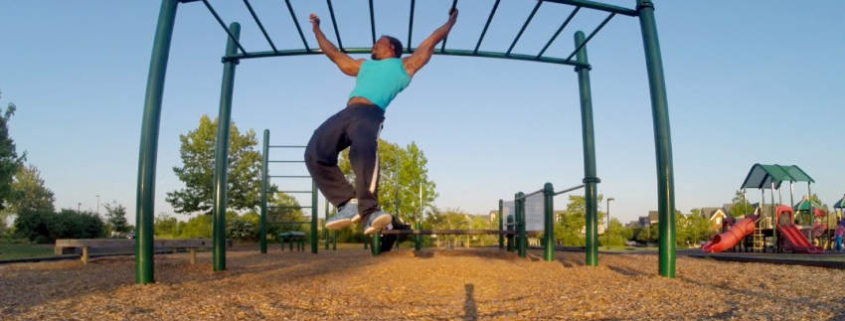Dead-Hanging (Brachiate) For Shoulder Pain
“Science is about defining truths about nature through experiment or experience.” – Richard Feynman, nuclear physicist
Many people suffer from shoulder pain at some point in their lives. There are many contributing factors that can lead to the cause of shoulder pain such as arthritis, bursitis, rotator cuff injuries, and even torn tendons or ligaments.
Understanding the anatomy of the shoulder is critical if you want to restore and maintain shoulder health. The rotator cuff muscles of the shoulder attach to various spots on the head of the upper arm bone (humerus). Above the humerus is the tip of the shoulder blade (acromion). This tunnel where many tendons, ligaments and other soft tissue have to pass is called the coracoacromial arch. The rotator cuff tendons lie between the acromion and the humerus.
Inappropriate movements like upright rowing and lateral arm raises, the rotator cuff tendons can get pinched or snagged between the two bones, causing irritation and eventual wear-and-tear.
With time, gravity, injuries, poor posture, inappropriate exercise or lack of use, shoulder deformation is encouraged causing the acromion to become hooked downward. This will narrow and compress this tunnel and all that soft tissue begins to degenerate. Shoulder pain and complications ensuing.
Orthopaedic surgeon Dr. John M. Kirsch, conducted research through a series of CT scans performed in 2004 to study the mechanics of the hanging exercise in the shoulders of live subjects. The study found that this simple exercise called relaxed hanging aka ‘brachial hanging’ was helpful in certain shoulder problems. The idea is that when the arm is fully overhead (in flexion), the upper arm bone (humerus) will press against the acromion (tip of the shoulder blade) and eventually reshape it. Hanging also stretches and strengthens the supraspinatus tendon. Supraspinatus tendon is particularly responsible for shoulder stability and strength.
Brachiating may help relieve tension through the back and shoulder. The effect of gravity pulls our posture down causing a negative compressive impact on our muscles, fascia, bones and joints. Brachiating is hanging from a bar for a few seconds each day and work your way up to being able to do it for an interval of between thirty seconds and a minute. Your goal may be to be able to hold on and hang with your feet in the air. But you can also do it with your feet on the ground for support. It depends on your current strength and endurance level.
If you have shoulder issues, pain and dysfunction consult with your local osteopath who will be able to thoroughly assess the health of your shoulders, neck, spine and posture. After taking a case history and performing an examination, a diagnosis may be reached and referral for imaging made if necessary.
Please do not hesitate to contact an osteopath for hands on osteopathic treatment to help improve the muscles and fascia of the shoulder girdle combined with appropriate postural and exercise advice.
If you are injured or are simply not strong enough to hang on with your feet in the air, don’t force it.
View a list of common complains that Osteopathy can assist with
Discovery the benefits of Osteopathy
- What is Osteopathy?
- Adult health issues
- Babies and Children
- During and after pregnancy
- Common Complaints
- Testimonials
- Sports Injuries
- Genral Osteopathy FAQs
- The Science & Reasearch



